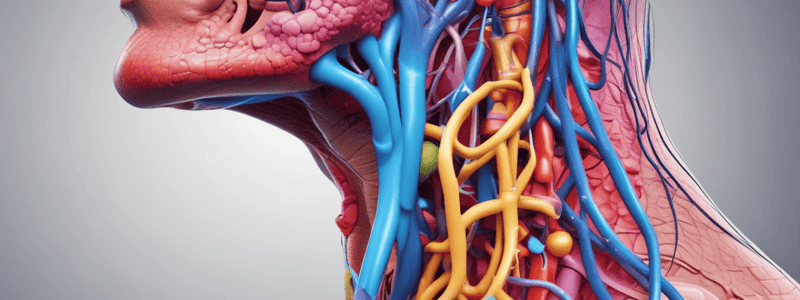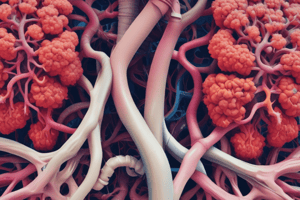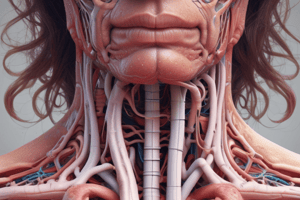Podcast
Questions and Answers
Which cells are responsible for gas exchange in the alveoli?
Which cells are responsible for gas exchange in the alveoli?
- Type III alveolar cells
- Alveolar macrophages
- Ciliated epithelial cells
- Type I alveolar cells (correct)
What is the function of Type II alveolar cells?
What is the function of Type II alveolar cells?
- Immune defense
- Gas exchange
- Production of surfactant (correct)
- Oxygen sensing
What are the components of the respiratory membrane?
What are the components of the respiratory membrane?
- Alveolar epithelium, blood vessels and capillary endothelium
- Alveolar epithelium, capillary endothelium and blood vessels
- Alveolar epithelium, capillary endothelium, and basement membrane (correct)
- Alveolar epithelium, basement membrane and blood vessels
Which is the correct location of the parietal pleura?
Which is the correct location of the parietal pleura?
What is the purpose of the negative pressure in the pleural space?
What is the purpose of the negative pressure in the pleural space?
Which structure covers the surface of the lungs?
Which structure covers the surface of the lungs?
What is the function of the negative pressure in the pleural space?
What is the function of the negative pressure in the pleural space?
Which cells are responsible for producing surfactant in the alveoli?
Which cells are responsible for producing surfactant in the alveoli?
What are the 3 large cartilages of the larynx ?
What are the 3 large cartilages of the larynx ?
What are the Pleura Functions?
What are the Pleura Functions?
Which way does O2 move in external respiration?
Which way does O2 move in external respiration?
What is the primary method of carbon dioxide transportation in the bloodstream?
What is the primary method of carbon dioxide transportation in the bloodstream?
Which muscles play a significant role in quiet exhalation?
Which muscles play a significant role in quiet exhalation?
Which way does CO2 move in external respiration
Which way does CO2 move in external respiration
Which way does oxygen move during internal respiration?
Which way does oxygen move during internal respiration?
Which way does CO2 move in internal respiration
Which way does CO2 move in internal respiration
How does oxygen primarily get transported?
How does oxygen primarily get transported?
Where are the peripheral chemoreceptors located?
Where are the peripheral chemoreceptors located?
What do central chemoreceptors respond to?
What do central chemoreceptors respond to?
What is the function of the pons respiratory centers?
What is the function of the pons respiratory centers?
How is your breathing affected by respiratory acidosis?
How is your breathing affected by respiratory acidosis?
What is hyperventilation?
What is hyperventilation?
Where are the central chemoreceptors located in the body?
Where are the central chemoreceptors located in the body?
Which center initiates the basic respiratory rhythm?
Which center initiates the basic respiratory rhythm?
What is hypoventilation?
What is hypoventilation?
What chemoreceptor respond primarily to PH and CO2 levels?
What chemoreceptor respond primarily to PH and CO2 levels?
What chemoreceptors respond to O2, CO2, and PH
What chemoreceptors respond to O2, CO2, and PH
Where are the respiratory centers found?
Where are the respiratory centers found?
What do peripheral chemoreceptors respond to?
What do peripheral chemoreceptors respond to?
Which of the following best describes the effect of emphysema on compliance in lung tissue?
Which of the following best describes the effect of emphysema on compliance in lung tissue?
What happens to the lung tissue and compliance in fibrosis?
What happens to the lung tissue and compliance in fibrosis?
What branch of the ANS causes bronchodilation
What branch of the ANS causes bronchodilation
What is the function of gastrin in the digestive system?
What is the function of gastrin in the digestive system?
How does HCl contribute to digestion?
How does HCl contribute to digestion?
Which of the following accurately describes the role of intrinsic factor?
Which of the following accurately describes the role of intrinsic factor?
What happens to pepsinogen during digestion?
What happens to pepsinogen during digestion?
Which substance is responsible for activating pepsinogen to its active form, pepsin?
Which substance is responsible for activating pepsinogen to its active form, pepsin?
What is internal respiration?
What is internal respiration?
Flashcards
What is the role of HCl in digestion?
What is the role of HCl in digestion?
Activates pepsinogen to pepsin, killing microbes in the stomach.
What is pepsinogen?
What is pepsinogen?
A precursor to pepsin; converted by hydrochloric acid.
What is the function of gastrin?
What is the function of gastrin?
Stimulates the secretion of acid (HCl) in the stomach.
What is intrinsic factor?
What is intrinsic factor?
Signup and view all the flashcards
What happens in emphysema?
What happens in emphysema?
Signup and view all the flashcards
What is internal respiration?
What is internal respiration?
Signup and view all the flashcards
What are the three large cartilages of the larynx?
What are the three large cartilages of the larynx?
Signup and view all the flashcards
What are Type I and Type II alveolar cells?
What are Type I and Type II alveolar cells?
Signup and view all the flashcards
What is the respiratory membrane?
What is the respiratory membrane?
Signup and view all the flashcards
What is the visceral pleura?
What is the visceral pleura?
Signup and view all the flashcards
What is the parietal pleura?
What is the parietal pleura?
Signup and view all the flashcards
Why is negative pressure important in the pleural space?
Why is negative pressure important in the pleural space?
Signup and view all the flashcards
What are the functions of the pleura?
What are the functions of the pleura?
Signup and view all the flashcards
What are the primary muscles of quiet inhalation?
What are the primary muscles of quiet inhalation?
Signup and view all the flashcards
What happens to O2 during external respiration?
What happens to O2 during external respiration?
Signup and view all the flashcards
What happens to O2 during internal respiration?
What happens to O2 during internal respiration?
Signup and view all the flashcards
What happens to CO2 during internal respiration?
What happens to CO2 during internal respiration?
Signup and view all the flashcards
What happens to CO2 during external respiration?
What happens to CO2 during external respiration?
Signup and view all the flashcards
How is oxygen transported in the blood?
How is oxygen transported in the blood?
Signup and view all the flashcards
How is carbon dioxide transported in the blood?
How is carbon dioxide transported in the blood?
Signup and view all the flashcards
Where are the respiratory centers located?
Where are the respiratory centers located?
Signup and view all the flashcards
What is the role of the medullary respiratory center?
What is the role of the medullary respiratory center?
Signup and view all the flashcards
Role of the pons respiratory centers?
Role of the pons respiratory centers?
Signup and view all the flashcards
What are peripheral chemoreceptors?
What are peripheral chemoreceptors?
Signup and view all the flashcards
What are central chemoreceptors?
What are central chemoreceptors?
Signup and view all the flashcards
What happens during respiratory acidosis?
What happens during respiratory acidosis?
Signup and view all the flashcards
What is hyperventilation?
What is hyperventilation?
Signup and view all the flashcards
Study Notes
Digestive System
- HCl activates pepsinogen to pepsin and kills microbes
- Pepsinogen is a precursor to pepsin
- Gastrin stimulates acid secretion
- Intrinsic factor is essential for B12 absorption
Respiratory System
- In emphysema, alveolar walls are damaged, reducing surface area for gas exchange
- Internal respiration is the process of exchanging O2 and CO2 between the blood and tissues
- The three large cartilages of the larynx are the Thyroid, Cricoid, and Epiglottis
- Type I alveolar cells and Type II alveolar cells are found in alveoli
- The respiratory membrane consists of alveolar epithelium, capillary endothelium, and basement membrane
Pleura and Respiratory Movement
- The visceral pleura covers the surface of the lungs
- The parietal pleura lines the inside of the chest wall, covering the thoracic cavity
- The negative pressure in the pleural space helps in lung expansion
- Pleura functions include lubrication, protection, and pressure gradient creation
- The primary muscles of quiet inhalation are the diaphragm and external intercostal muscles
Gas Exchange and Transport
- O2 moves from the alveoli into the blood during external respiration
- O2 moves from the blood to the tissues during internal respiration
- CO2 moves from the tissues to the blood during internal respiration
- CO2 moves from the blood into the alveoli during external respiration
- Oxygen is primarily transported bound to hemoglobin in red blood cells
- Carbon dioxide is transported as bicarbonate ions in plasma, bound to hemoglobin, or dissolved in plasma
Respiratory Control
- Respiratory centers are located in the medulla oblongata and pons of the brainstem
- The medullary respiratory center, specifically the pre-Bötzinger complex, initiates the basic respiratory rhythm
- The pons respiratory centers modulate the rhythm generated by the medulla to smooth the respiratory pattern
- Peripheral chemoreceptors are located in the carotid and aortic bodies and respond to low O2, high CO2, and low pH
- Central chemoreceptors are located in the medulla and respond to changes in CO2 concentration or pH changes in cerebrospinal fluid
Respiratory Acidosis and Hyperventilation
- Breathing becomes deeper and more rapid to expel CO2 and increase pH during respiratory acidosis
- Hyperventilation is rapid or deep breathing leading to decreased CO2 levels
Studying That Suits You
Use AI to generate personalized quizzes and flashcards to suit your learning preferences.




